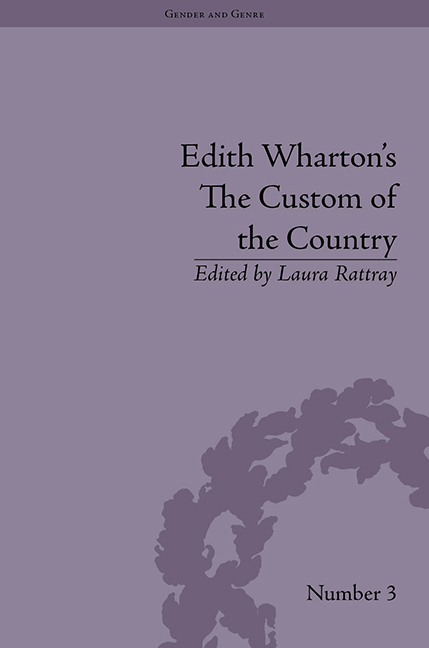Book contents
- Frontmatter
- CONTENTS
- Acknowledgements
- Editorial Note
- List of Contributors
- List of Figures
- Introduction
- 1 The Custom of the Country: Edith Wharton's Conversation with the Atlantic Monthly
- 2 When the Reading Had to Stop: Readers, Reading and the Circulation of Texts in The Custom of the Country
- 3 ‘Don't Cry – it ain't that Kind of a Story’: Wharton's Business of Fiction, 1908–12
- 4 Worst Parents Ever: Cultures of Childhood in The Custom of the Country
- 5 Crude Ascending the Staircase: Undine Spragg and the Armory Show
- 6 ‘It's Better to Watch’: Compulsive Voyeurism in The Custom of the Country and The House of Mirth
- 7 A ‘Mist of Opopanax’: Mapping the Scentscape of The Custom of the Country
- 8 Landscape with the Fall of Undine
- 9 Girls from the Provinces: Wharton's Undine Spragg and Cather's Thea Kronborg
- 10 Men at Work in The Custom of the Country
- 11 ‘Lost in Translation’: Financial Plots and the Modernist Reader in The Custom of the Country
- Notes
- Index
Introduction
- Frontmatter
- CONTENTS
- Acknowledgements
- Editorial Note
- List of Contributors
- List of Figures
- Introduction
- 1 The Custom of the Country: Edith Wharton's Conversation with the Atlantic Monthly
- 2 When the Reading Had to Stop: Readers, Reading and the Circulation of Texts in The Custom of the Country
- 3 ‘Don't Cry – it ain't that Kind of a Story’: Wharton's Business of Fiction, 1908–12
- 4 Worst Parents Ever: Cultures of Childhood in The Custom of the Country
- 5 Crude Ascending the Staircase: Undine Spragg and the Armory Show
- 6 ‘It's Better to Watch’: Compulsive Voyeurism in The Custom of the Country and The House of Mirth
- 7 A ‘Mist of Opopanax’: Mapping the Scentscape of The Custom of the Country
- 8 Landscape with the Fall of Undine
- 9 Girls from the Provinces: Wharton's Undine Spragg and Cather's Thea Kronborg
- 10 Men at Work in The Custom of the Country
- 11 ‘Lost in Translation’: Financial Plots and the Modernist Reader in The Custom of the Country
- Notes
- Index
Summary
The Custom of the Country, first published on 18 October 1913, has been described as Edith Wharton's ‘most powerful’ novel, ‘her greatest book’, her ‘most ambitious masterpiece’ and a ‘tour de force’. Charting the career of the American-branded Undine Spragg of Apex, Wharton presents her readers with the modern material girl, a young woman surrounded by dazzling lights and mirrors, her sights set firmly on the centre of the social gaze. While The House of Mirth's precarious insider Lily Bart fatally spirals down the social scale, ‘thrown out into the rubbish heap’ and all its attendant horrors, Undine Spragg, the outsider, indefatigably works her way up and forces a way in. At the novel's remarkably open-ended close, Undine has realized her dazzling success (while never recognizing its casualties) only to discover ‘under all the dazzle a tiny black cloud remain[s]’ (p. 594). Undine Spragg Moffatt Marvell de Chelles Moffatt's career of acquiring and discarding husbands debars her from the role of Ambassador's wife – the one part, she tells herself, for which she was really made.
While Wharton herself would come to regard The Custom of the Country as one of her finest works, its genesis proved the most protracted and disrupted of any novel in her long and prolific career. As the author toiled on the manuscript in fits and starts between 1907 and 1913, progress was regularly interrupted, and the novel intermittently set aside in favour of other writings.
- Type
- Chapter
- Information
- Edith Wharton's The Custom of the CountryA Reassessment, pp. 1 - 14Publisher: Pickering & ChattoFirst published in: 2014

